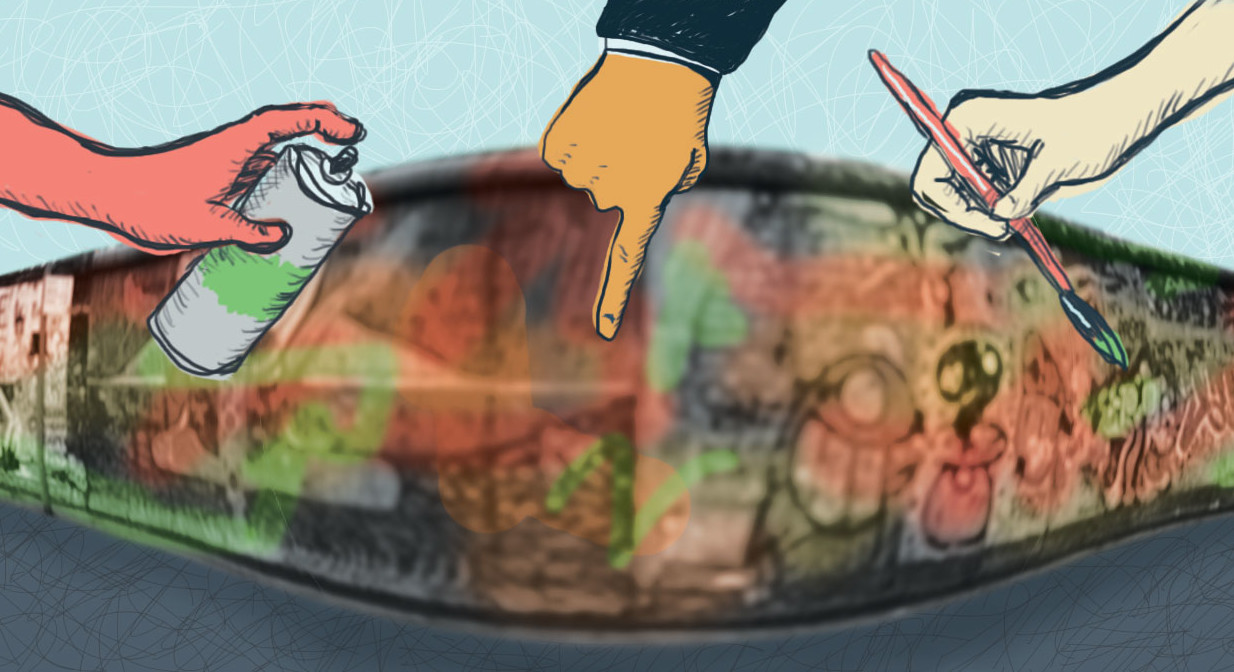The 7,000 illuminated balloons winding through Berlin this November 9 marked the 25th anniversary of the fall of the Berlin Wall. Despite the celebration, the wall is in the midst of an identity crisis. While the western side of the wall had always been covered in graffiti, the murals painted on the eastern side were revolutionary — under communist control, armed guards were told to shoot any would-be vandals (and escapees) on sight. One year after the wall fell in 1989, artists teamed up to create a 1,300-foot-long memorial to freedom that juxtaposed their new paintings against those that had adorned the eastern side of the wall before its fall. The result was a public art exhibition called the East Side Gallery, a vibrant mural including images of kissing politicians and a white dove that expressed hope for a better future. But conflict between the government, the public and the original artists has raised questions about the nature of freedom and artistic expression in a reunified Germany.
Since its creation in 1990, the gallery has not remained a static mural installation — pieces have been chipped away and vandalized, and the weather has slowly deteriorated the paint. In 2000, the Berlin city government claimed that the murals had been destroyed and subsequently made plans to restore them, offering the original artists €3,000 to repaint their works. Some artists rejected this offer — a few looking for higher profits, others arguing that the wall was intended to be a monument to freedom. For years, the prohibition of artwork on the eastern side of the wall was maintained through the brutality of communist guards. The paintings were meant to celebrate the absence of these violently enforced restrictions. But the German government has now decided, 25 years later, to no longer permit visitors to graffiti the wall, to paint over existing graffiti and to then restore the original murals.
Some of the original painters have reveled in the wall’s commercialization. As a result, these artists originally supported the restoration project — for a price. The wall has brought in millions of euros of tourist revenue, and artists have demanded to see a portion of the profits, decrying the €3,000 restoration fee as laughable in the face of the multi-million euro restoration budget. Instead of negotiating, the government objected to these artists’ higher counteroffers and whitewashed the wall, hiring new artists to copy the original works. As a result, several of the original artists sued the government in 2011 for copyright infringement, demanding to see payment for their pieces. The lawsuit is still ongoing, but the questions brought up by the East Side Gallery can’t be solved in a courtroom; they address the very nature of public art and its interaction with the public, the government and artists.
Through public art, artists try to “heighten our awareness and question our assumptions,” says the US-based Association for Public Art. Although art has been increasingly democratized, the process has been, in some ways, a reaction to the public art of the past in which one distinct point of view was represented: the commissioner’s. Still, public art doesn’t always address the needs of the community, particularly in cases where the art offers no outlet for community interaction. In the face of new austerity measures and a youth poverty rate of 20 percent, Germany’s dedication of public funding to art can seem at best idealistic and at worst cruel. Cultural critic and former California Institute of the Arts professor Michael Asher argued that to say public art is inherently democratic is to ignore the fact that such art is based on government control and commission and thus on access to power and privilege. The prioritization of monied interests explains why Bodo Sperling, a founder of the original gallery, calls the product of the government’s new changes the “Disneyland version” of the Berlin Wall. In this sense, public art is often not quite as democratic as it may initially seem.
As a political statement, the East Side Gallery professes the freedom of a democratized Germany. Meanwhile, the government still retains control over the piece, deciding without formal public or artist input whether or not the work has been destroyed, as well as whether restorations will take place and who will complete them. The issue of the Berlin Wall is complex because it necessitates interactions between German citizens, the government, the original artists and even spectating tourists. The solution to Germany’s public art problem requires privileging one view: either that of the government or that of the artists. Since it is fundamentally impossible to create a single work that can accurately reflect the lived experiences of millions of Germans under communist rule, it makes the choice of who tells their story all the more pressing. As these questions come up, however, the city must weigh the balance between public participation and the lack thereof. The restoration of the wall must take into account not just the story of the wall under communism, but also its evolution since that time. And ultimately, if the government wants to preserve Berlin’s rich history, it must maintain both the image and intent of the gallery — a commitment to the freedom of artistic expression that came with a reunified Germany.
Art by Olivia Watson.
